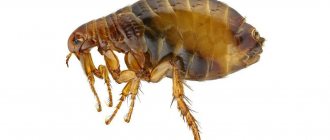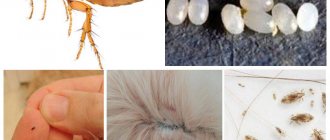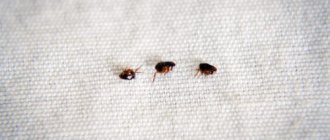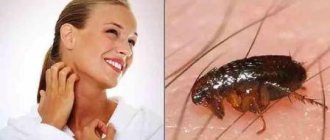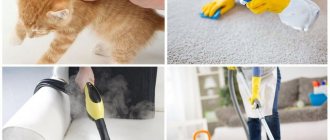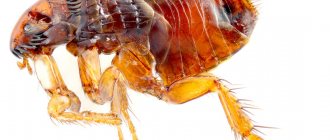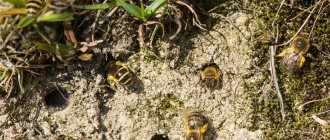People try to get rid of fleas in different ways - both by using home remedies and using chemicals. But the effect quickly wears off, and the fleas breed again. Why is that?
It’s not just the product that influences the results. It is important to understand the biology of parasites and why they appear.
In this article, we will give advice to homeowners on where to start fighting earth fleas and how to finish it correctly, taking into account all the nuances, in a comprehensive manner. Our recommendations on how to get rid of fleas are as effective as possible; they are used in their practice by experienced exterminators.
How do fleas get into the house?
- A roaming pet will most likely sooner or later bring fleas on itself. They lie in wait for him in dense vegetation, shady areas of courtyards and parks, and in the basements of houses.
- You yourself can bring parasites into your home. Getting flea eggs caught in mud on the soles of shoes or trousers is much easier than many people think.
- Stray dogs and cats throw flea eggs into a private yard or porch of a house. After a couple of weeks, they develop into adult insects, and getting into the room becomes a matter of technology.
- If there are rats or mice in the basement or attic, this creates a potential breeding ground for rat fleas.
Means for struggle
«
How to poison annoying fleas? is a question to which most people do not know a clear answer. It will be effective to use specially developed chemicals that guarantee the killing of insects.
Dichlorvos is often used, but besides it there are also substances such as Chlorpirimark and Ultra Effect. The packaging of chemical compounds must be marked: “To combat crawling insects.” When repeating disinfestation, if the first procedure does not produce results, you can use another chemical, since sometimes fleas develop immunity to poisons.
The fight against earthen fleas can last several months, so be patient and do not despair if the results do not appear immediately.
How to get rid of earthen fleas in the house forever in 1 month
Adult fleas lay 50 eggs per day in an animal's fur. But a living creature does not stand still, so eggs fall onto carpeting, upholstery and wherever it runs, lies, sleeps or plays.
Do you want to get rid of earthen fleas completely and permanently? Be guided by the principle: the entire territory of the house requires total attention when carrying out disinfestation. The first mistake most people make when poisoning fleas is to ignore it. The result of careless or incomplete treatment: eggs, larvae and pupae (which is 90% of the population) remain alive and well, and the number of parasites returns to their previous level. However, that's not all. If you dig deeper, there are many things that influence efficiency. More on all this below in order.
Maliciousness
The light-legged flea beetle is a pest of cruciferous crops. Adults and larvae are harmful. The beetles gnaw the leaves, the larvae feed on the leaf pulp. The vital activity of the pest reduces the qualitative and quantitative indicators of the yield of cruciferous crops.
The economic threshold of harmfulness is established in the following phases:
- when planting seedlings - from three to five beetles per plant when 10% of the plants are colonized;
- formation of whorls of leaves - ten beetles per plant when 25% of the plants are colonized;
- the beginning of head formation - from three to five beetles per plant when more than 50% of the plants are colonized.
pesticidy.ru
What to do if fleas appear again
Let's imagine the situation. More than 3 days have passed after the baiting, and you continue to observe live fleas, which have not changed their behavior since the beginning of treatment. This effect is 100% due to their increased chemical resistance.
Some insects may inherit from their ancestors “immunity” to one or more classes of insecticides. Such “mutants” can be destroyed by a drug from a group that has not been used before, or at least for a long time. In a good way, the new composition should include active ingredients to which fleas are not sensitive.
If you want to get rid of earthen fleas forever, poison the insects after 2-3 weeks with the same product you used the first time. But keep in mind that this will “finish off” the remaining number only if a few individuals survive after the first treatment. If there is no effect, treat the room with a drug from a different chemical group.
However, resistance is far from the only reason for failure.
There are no drugs approved for everyday use on the Russian market .
For example, it is known which products quickly destroy adult fleas, but they have little effect on larvae. The latter are effectively controlled by growth regulators belonging to a separate class of insecticides. But they do not affect adults. As a result, the population quickly recovers.
The ideal solution would be a product containing both an FOS or pyrethroid component and a growth regulator. But there are only a few liquid pesticides with this composition, and there are none at all approved for use at home. Possible solutions to this situation are to use several drugs in a tank mixture, which some pest control services include in their strategies, or to re-treat with a “larval” class drug.
Thus, if the services of a pest control service are not yet your option, do not despair. You can solve this problem on your own, using one cunning method, which, nevertheless, is available to everyone at home. The secret is this: combine a liquid poison, which “squashes” adult fleas, with boric acid powder, which kills the larvae, or diatomaceous earth, which dries them out. Let's take a closer look at these tools.
How to check the result and create a “barrier”
Place 20x30cm sticky white sheets (you can put glue on them) again in the same areas of suspected or actual flea activity. We have already written about this method above. Some people use a water trap for control.
If, according to the results of the check, there are a lot of fleas, repeat the treatment with the same or a different drug. If there are practically no fleas left, or you find single individuals, use the fixing method of “barrier” treatment.
The action of the “barrier” is aimed at the main part of the population – eggs, larvae and pupae. The essence of the method is to sprinkle a mixture of dry natural insecticide over the carpet. We recommend the following powders for this:
1. Pyrethrum . You can either look for it in a pharmacy or order the Eco Absolut Chamomile product in an online store, packaged in a plastic doypack. The product as an insecticide is slightly toxic and, therefore, ineffective. But it is quite suitable as an adjunct to deter fleas.
2. Boric acid , disinfectant powder. Regular disinfectant powder, packaged in 10 gram bags, is sold at the pharmacy. Entomologists have proven that boric acid powder does not cause resistance in insects due to its specific mechanism of action. It also has a lethal effect on the most resistant stages of fleas - the worm-like larvae.
3. Diatomite . Can be purchased in the form of finished raw materials intended for food, gardening or cosmetic purposes. Or produced specifically to combat insects. Such products include professional preparations “Ecokiller” and “Hector”. All of them are designed for a sorbing effect, drying flea larvae and pupae, drawing moisture out of them.
Mixtures show a more stable barrier result:
- Dry mixture of pyrethrum powder with boric acid (you can prepare it yourself)
- A mixture of diatomite with boric acid powder. You can “make it” with your own hands, or buy it ready-made in such a product as “Hector for cockroaches”. This drug copes with the residual number of fleas no worse than with cockroaches.
Next, leave the “powder barrier” for a day, then vacuum it up. Repeat the procedure 1-3 times throughout the month - this will systematically destroy the eggs and emerging larvae.
Bites
The bites of these insects look like a small red spot on the skin, which quickly disappears and leaves no trace. But this is observed only in cases where the insect has not infected a person with an infectious disease. The cause of detection may be not only redness and itching. How dangerous are bites for humans? This question interests almost all people who are faced with this problem. In many cases, swelling, burning and allergic reactions are observed. Sometimes the bites are completely harmless and cause only minor itching.
Photo: Flea bites
Areas of flea exposure to the skin should be treated to prevent infection. Any antiseptic will do for this. It is recommended to use medications only after consultation with a doctor.
Speaking about special drugs, we should mention:
- Diphenhydramine. Helps get rid of itching and other consequences of flea bites. But this medicine causes drowsiness, so even if it is sold without a prescription, it is better to ask your doctor for advice.
- Hydroxyzine. The drug is available only by prescription and is used to reduce the level of histamines in the body, which significantly alleviates the condition.
The following are used as folk remedies for treating bites:
- green tea decoction;
- fresh calendula or plantain juice;
- aloe juice
It will not be possible to find exact information about the timing of getting rid of bites, because everything depends on the individual characteristics of the bitten person and the infection caused by the flea.
How to treat pets for fleas
Getting rid of fleas from a pet is a necessary stage of their destruction, which we did not include in the main list of measures.
The fact is that so-called earthen fleas often appear in houses that do not keep their pets. There, their source is rodents, which are found in the yard of almost any private home. Or stray animals, from which it would also be good to protect the site. In practice, this is difficult to implement, and in some cases impossible.
What to do?
You should start treating the animal as soon as you are sure that there are no rodents (at the second stage). Often they are not there because there is some other animal at home that scares them away with its smell.
Any warm-blooded mammal is a kind of beacon for fleas, a living bait. If you do not have the opportunity to protect the area from wild and stray animals 100%, it may be worth considering the option of catching this animal and applying professional products to its fur that would repel or kill fleas (collar, drops on the withers).
Fleas in their adult stages spend their lives in animal fur rather than carpet. Therefore, in order to get rid of fleas in the house, be sure to treat the animal while indoors. Otherwise, the adults will continue to bite the pet and lay eggs.
In addition, if you do have pets, unprotected they will bring in new fleas from the street, and the infestation will repeat again and again.
Attention!
Animals are treated only with veterinary drugs.
Never use insecticides intended for disinfestation of premises on animals. Today, flea treatments for animals are available in various forms: drops, shampoos, collars, preparations for internal use. Use only those products that are intended for this type of animal, read the instructions carefully.
From the experience we have, we can definitely recommend drops for the withers. This preparative form of the anti-flea drug is most effective in treating an animal against fleas. Which product to choose should be consulted with a veterinarian in the store.
Morphologically related species
In terms of morphology (appearance) of the imago, the flea beetle (Phyllotreta undulata) is close to the described species. The main differences: the forehead with a transverse stripe of dots, the crown without dots, yellow stripes sometimes very thin, almost everywhere of the same width, the pronotum is black, sometimes with a faint metallic tint, slightly smaller in size – 2–2.3 mm.
In addition to the indicated species, Phyllotreta schreineri is often found, also similar in adult morphology to the light-legged flea beetle (Phyllotreta nemorum).
Catnip
Catnip is a herbaceous perennial and has a strong aroma, thanks to which you can save garden crops from harmful insects. This is due to the high content of essential oils. The plant appears to be low-growing, but it is best to plant it along the beds, since the strong aroma attracts cats. Catnip is not only eaten, but also successfully used in folk medicine.
Appearance
Quite typical for beetles belonging to the order Coleoptera . They have an elongated body, reliably protected by dense, hard elytra. The color can vary, from light green to almost black , it is usually monochromatic and has a metallic sheen. Some types are decorated with transverse stripes of contrasting colors.
The flea has small transparent wings with which it flies short distances. Long flights are beyond the capabilities of insects.
The antennae of the beetles are long, black, and dotted. There are usually 6 legs, like all other beetles. A special feature of fleas is their hind legs. Their first segments (“hips”) are thickened, and their “legs” are elongated, due to which the bugs have good jumping ability. It is because of this ability that fleas are confused with ordinary blood-sucking fleas .
REFERENCE ! In fact, fleas are not related to flea beetles. Colorado beetles and ladybugs can be considered close relatives of these pests.
Next you will see a photo of earthen fleas:
- Larvae.
These are small worms with soft outer coverings of an off-white color. The body consists of many segments, the head is dark. Legs 3 pairs.
- Egg.
It has an elliptical shape, slightly elongated upward. The color is light, yellowish or greenish.
- Doll.
The larva acquires a snow-white coloring of the integument. On top it is covered with a hard shell of beige or yellow color.


